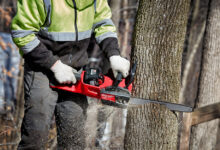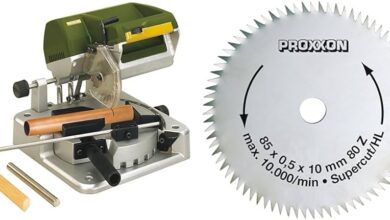Contents
Introduction
As winter approaches, it’s crucial to prepare your chainsaw for storage to ensure its longevity and optimal performance come spring. A well-maintained chainsaw can last for years, but improper storage can lead to rust, damage, and reduced efficiency. This comprehensive guide will provide you with all the essential information you need to store your chainsaw safely and effectively during the winter months.
Before we delve into the specifics of chainsaw storage, it’s worth understanding the potential risks associated with improper storage. Rust is a major concern, as moisture and humidity can quickly corrode metal components. Damage to the engine, carburetor, and other vital parts can occur due to freezing temperatures and exposure to the elements. Additionally, rodents and other pests can nest inside the chainsaw, causing further damage.
By following the proper storage procedures, you can minimize these risks and ensure your chainsaw remains in top condition. The following sections will cover every aspect of chainsaw storage, from preparation and cleaning to choosing the right storage location and protecting against pests.
Strengths of Chainsaw Storage in Winter
Proper chainsaw storage in winter offers numerous benefits that will ultimately prolong the life of your equipment and enhance its performance:
1. Prevents Rust and Corrosion: By storing your chainsaw in a dry, moisture-free environment, you can effectively prevent rust from forming on metal components. Rust can damage the engine, carburetor, and other vital parts, leading to costly repairs or premature replacement.
2. Protects from Freezing Temperatures: Extreme cold can cause damage to the engine, carburetor, and other components. Storing your chainsaw in a warm, sheltered location will protect it from freezing temperatures and prevent potential damage.
3. Keeps Pests Away: Rodents and other pests are attracted to chainsaws, especially during winter when food sources are limited. Proper storage will keep these pests away and prevent them from nesting inside the chainsaw, which can cause damage to wires and other components.
Weaknesses of Chainsaw Storage in Winter
While chainsaw storage in winter is generally beneficial, there are a few potential drawbacks to be aware of:
1. May Require Additional Space: Finding a suitable storage location for your chainsaw may be challenging, especially if you have limited space. You may need to allocate a specific area in your garage or shed for chainsaw storage.
2. Potential for Damage During Storage: If your chainsaw is not properly secured during storage, it could fall or get knocked over, resulting in damage. It’s important to choose a storage location where the chainsaw will be stable and secure.
3. Inconvenience of Retrieval: Depending on the storage location you choose, retrieving your chainsaw in the spring may be inconvenient. You may need to move other items or equipment to access the chainsaw.
Choosing the Right Storage Location
Selecting the right storage location for your chainsaw is crucial to ensure its protection from the elements and pests. Here are some key factors to consider:
1. Temperature: Store your chainsaw in a location that remains above freezing temperatures throughout the winter. Extreme cold can damage the engine, carburetor, and other components.
2. Moisture: Choose a storage location that is dry and free from moisture. Moisture can lead to rust and corrosion on metal components, especially if the chainsaw is not properly cleaned before storage.
3. Access: While you want to store your chainsaw in a secure location, it’s also important to choose a place where you can easily access it in the spring when you need to use it.
Preparing Your Chainsaw for Storage
Before storing your chainsaw for winter, it’s essential to prepare it properly to ensure its longevity and optimal performance come spring. Follow these steps:
1. Clean the Chainsaw: Remove all dirt, debris, and sawdust from the chainsaw using a brush or compressed air. Pay special attention to the engine, carburetor, and air filter.
2. Sharpen the Chain: A dull chain can put unnecessary strain on the engine and reduce cutting efficiency. Sharpen the chain before storing it to ensure it’s ready to use in the spring.
3. Lubricate Moving Parts: Apply a light coat of lubricant to all moving parts, such as the chain, guide bar, and any exposed gears or bearings. This will help prevent corrosion and ensure smooth operation when you use the chainsaw again.
Protecting Against Pests
Rodents and other pests are attracted to chainsaws, especially during winter when food sources are limited. To prevent pests from nesting inside your chainsaw and causing damage, take these precautions:
1. Store the Chainsaw Off the Ground: Elevate your chainsaw off the ground by placing it on a shelf, table, or other elevated surface. This will make it less accessible to rodents.
2. Use Mothballs or Pest Repellents: Place mothballs or other pest repellents around the storage area to deter rodents and other pests from approaching your chainsaw.
3. Inspect the Chainsaw Regularly: Check your chainsaw periodically during storage for signs of pest activity. If you notice any droppings or damage, take immediate action to remove the pests and prevent further damage.
Frequently Asked Questions
1. **How long can I store my chainsaw?**
Chainsaws can be stored for several months during the winter if properly prepared and stored in a suitable location.
2. **Can I store my chainsaw in a shed?**
Yes, you can store your chainsaw in a shed as long as it is dry and free from moisture. Ensure the shed is well-ventilated to prevent condensation from building up.
3. **Should I drain the fuel from my chainsaw before storing it?**
Yes, it is recommended to drain the fuel from your chainsaw before storing it to prevent gum and varnish from forming in the carburetor and fuel system.
4. **How do I protect my chainsaw from rust?**
Clean your chainsaw thoroughly before storing it and apply a light coat of oil to metal surfaces to prevent rust from forming.
5. **What is the best way to store a chainsaw chain?**
Soak the chain in oil and wrap it around the guide bar loosely to prevent kinking or deformation.
6. **How do I prepare my chainsaw for use after storage?**
Before using your chainsaw after storage, check the fuel and oil levels, sharpen the chain if necessary, and ensure all nuts and bolts are properly tightened.
7. **How often should I inspect my chainsaw during storage?**
It is recommended to inspect your chainsaw periodically during storage for any signs of damage or pest activity.
8. **What should I do if I notice pests in my chainsaw?**
If you notice pests in your chainsaw, remove them immediately and clean the chainsaw thoroughly. Apply pest repellent to the storage area to prevent further infestation.
9. **Is it safe to store my chainsaw on its side?**
It is not recommended to store your chainsaw on its side as fuel or oil may leak out.
10. **Can I store my chainsaw in a garage?**
Yes, you can store your chainsaw in a garage as long as it is dry and free from moisture. Ensure the garage is well-ventilated to prevent condensation from building up.
Conclusion
Proper chainsaw storage in winter is essential to ensure its longevity and optimal performance. By following the guidelines outlined in this comprehensive guide, you can protect your chainsaw from rust, damage, and pests, ensuring it is ready to use when you need it. Remember to prepare your chainsaw for storage, choose the right storage location, protect against pests, and regularly inspect it during storage.
Investing in proper chainsaw storage will pay dividends in the long run by extending the lifespan of your equipment and minimizing the need for costly repairs. By taking the time to properly store your chainsaw, you can enjoy years of reliable and efficient use.









